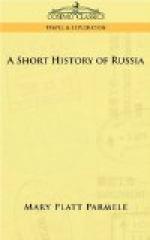But Russia is deficient in still another essential feature. Every other European country possesses a mountain system which gives form and solidity to its structure. She alone has no such system. No skeleton or backbone gives promise of stability to the dull expanse of plains through which flow her great lazy rivers, with scarce energy enough to carry their burdens to the sea. Mountains she has, but she shares them with her neighbors; and the Carpathians, Caucasus, and Ural are simply a continuous girdle for a vast inclosure of plateaus of varying altitudes,[1] and while elsewhere it is the office of great mountain ranges to nourish, to enrich, and to beautify, in this strange land they seem designed only to imprison.
It is obvious that in a country so destitute of seaboard, its rivers must assume an immense importance. The history, the very life of Russia clusters about its three great rivers. These have been the arteries which have nourished, and indeed created, this strange empire. The Volga, with its seventy-five mouths emptying into the Caspian Sea, like a lazy leviathan brought back currents from the Orient; then the Dnieper, flowing into the Black Sea, opened up that communication with Byzantium which more than anything else has influenced the character of Russian development; and finally, in comparatively recent times, the Neva has borne those long-sought civilizing streams from Western Europe which have made of it a modern state and joined it to the European family of nations.
It would seem that the great region we now call Russia was predestined to become one empire. No one part could exist without all the others. In the north is the zone of forests, extending from the region of Moscow and Novgorod to the Arctic Circle. At the extreme southeast, north of the Caspian Sea and at the gateway leading into Asia, are the Barren Steppes, unsuited to agriculture or to civilized living; fit only for the raising of cattle and the existence of Asiatic nomads, who to this day make it their home.
Between these two extremes lie two other zones of extraordinary character, the Black Lands and the Arable Steppes, or prairies. The former zone, which is of immense extent, is covered with a deep bed of black mold of inexhaustible fertility, which without manure produces the richest harvests, and has done so since the time of Herodotus, at which period it was the granary of Athens and of Eastern Europe.
The companion zone, running parallel with this, known as the Arable Steppes, which nearly resembles the American prairies, is almost as remarkable as the Black Lands. Its soil, although fertile, has to be renewed. But an amazing vegetation covers this great area in summer with an ocean of verdure six or eight feet high, in which men and cattle may hide as in a forest. It is these two zones in the heart of Russia that have fed millions of people for centuries, which make her now one of the greatest competitors in the markets of the world.




